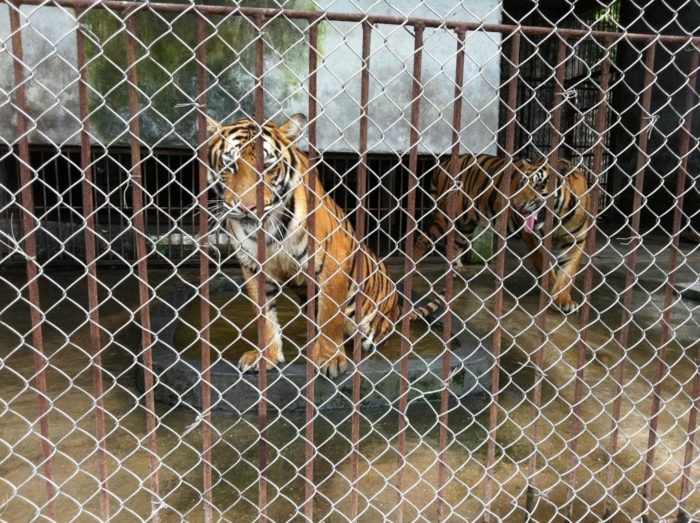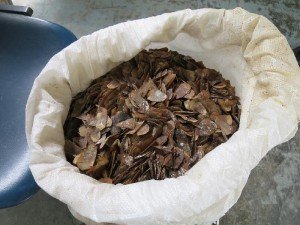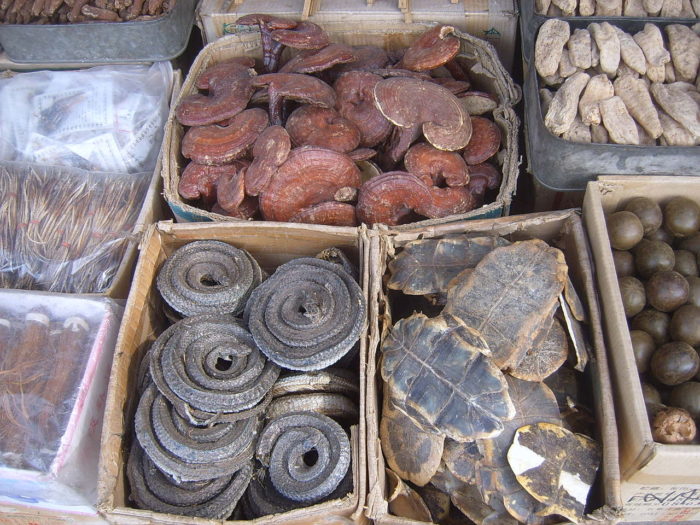China’s new wildlife law falls short of ‘Ecological Civilisation’



Credit: Vberger
Imagine walking into your local supermarket and seeing liquor made from tiger bones and deer antlers, frozen crocodile meat, powdered bear bile, ‘medicine’ made from musk deer, tins of spotted deer meat and giant salamander – all protected species, all priced and sitting on the shelves beside your daily necessities.
China’s Wildlife Protection Law is undergoing its first major revision in 26 years since it came into force. The draft, currently under public consultation, states for the first time that wildlife can be used in the manufacture of Chinese traditional medicine, healthcare products and food for profit. If this draft becomes law then these scenes could become a reality.
Is this what an ‘ecologically civilised’ society looks like?
The revision of the Wildlife Protection Law is part of a broader overhaul of China’s environmental laws, which have been brought into line with the concept of ‘Ecological Civilisation’ (a Government term recognising the need for a greener approach). But some of the content in a proposed draft of the new law runs contrary to these efforts.

Captive tigers, Gulin, China, 2011 (c) EIA
The overarching guidelines for ‘achieving Ecological Civilisation’ issued by the State Council and the Communist Party of China’s Central Committee calls for the protection of rare and wild fauna and flora. They require existing laws to “guide, standardise and limit the exploitation, use and protection of natural resources”.
Finally, the guidelines undertake to “promote a faster public shift to thrifty, green and low-carbon, civilised and healthy choices in clothing, food, homes, transportation and travel; and firmly oppose all types of luxury and excessive consumption”.
The eating of rare and endangered wildlife is reported to be a criminal act by legal interpretations. It is also questionable whether the use of endangered wildlife in medicine and healthcare products can be considered as “civilised and healthy”.
In its current draft, the new law (the only one in China to specify the protection of wildlife in its title) allows provincial authorities to approve the hunting of wildlife under special state protection for “captive breeding and other special purposes”. The draft also approves the trade and use of wild species for “public display (performance)”.
The wildlife under special state protection is classified as species which are rare, endangered and/or important for maintaining ecological balance. The draft does not specify the aim or nature of captive breeding for “public display”. Hence approval could be given to commercial breeding programmes or circuses that buy, sell and use nationally protected wildlife.
Captive breeding is a rapidly growing industry that often undermines conservation efforts. In February 2015, a Public Security Bureau head in Shenzhen held a banquet at which a giant salamander was served. The salamander in question had been farmed by an industry that is putting the future of this critically endangered species at risk. A recent study showed that the Chinese giant salamander has lost 80 per cent of its wild population, partly because of illegal poaching to supplement farmed populations, which often do not breed successfully.
It is a similar story for other heavily bred species in China, such as tigers, bears and spotted deer, various reptile species and tortoises.

Customs officials count 213 bear paws seized after two Russian men attempted to smuggle them into China (c) Reuters
Furthermore, wildlife products are often considered expensive luxury items, used as bribes when building ‘connections’. A trade in such products is therefore entirely out of line with the spirit of China’s national crackdown on corruption.
The shop shelf described in the introduction is not a figment of imagination. Most of the products described are already permitted for trade under certain administrative regulations, although remain in a legal grey zone.
Open source information shows that since 2003, Government authorities have made over a dozen announcements of companies and products granted ‘China wildlife utilisation management special marking’. The special mark permits trade in all sorts of rare and endangered wildlife products, such as ivory – although China recently promised to halt this as the country responds to growing international criticism.
For example, an announcement made in 2007 included almost 100 products from more than 80 firms, including “medicine containing saiga antelope antlers, pangolin scales, parts of rare snakes, musical instruments, leather goods, clothing, healthcare products, cosmetics made from rare snakes, tiger and leopard skins and skin products, stuffed wild animals, frozen and dried Siamese crocodile meat and liquors made from spotted deer velvets and blood.”
One lawyer with an interest in animal protection law said that the misuse of wildlife stems from legal loopholes. For example, the State Forestry Administration (an implementation authority) uses vague language in the existing law, which allows serious breaches to continue under the protection of its own departmental regulations.
The new revision retains some of that opaque language, such as “other special purposes”. It also intends to bring the above mentioned marking system into law and, for the first time, to create a list of protected wildlife to be bred for trade.

Pangolin scales seized in Hong Kong in June 2014, via customs.gov.hk
In 2013, during a consultation on regulations for the breeding of wildlife under special state protection, there was widespread opposition to the commercial exploitation of rare species. The regulations were shelved but similar rules are now appearing in the draft of the Wildlife Protection Law – a backwards step.
Take the tiger, for example, one of China’s most endangered species. Only 50 are left in the wild in China but more than 5,000 are kept in captivity. These tigers are mostly bred for profit and have no conservation value.
Although a UN convention called for the phasing out of commercial tiger breeding, the authorities in China turned a blind eye to the proliferation of tiger farms across the country and allowed the trade in captive-bred tigers – liquor products made by two of the biggest tiger farms were given permission by the State Forestry Administration for trade.
The trade has got out of control as recent headlines suggest. In 2014, tiger meat was served at a banquet in Leizhou and last year a tiger corpse was found in the street in Wenzhou. Tigers have been mistreated and abused in zoos across the country, while circus tigers have mysteriously showed up in private possession. These are all tigers farmed for profit.

The dead tiger discovered on the streets of Wenzhou, China, via Reuters/China Daily
.A recent report said that the past four decades have seen populations of terrestrial vertebrates in China drop by half, resulting in a huge loss in biodiversity.
The revision of the Wildlife Protection Law offers the chance to reverse this loss – and the first step would be to halt the commercial breeding of rare and endangered species and remove all clauses allowing their commercial use.
..
.

用于中药的动植物,摄影:Vberge
.

中国桂林人工繁育的老虎,摄影:EIA
试想一下,当你走进家门口一家普通的超市,货架上陈列有虎骨酒、鹿茸酒、冷冻鳄鱼肉、熊胆粉、麝香中成药、梅花鹿肉罐头、娃娃鱼等清一色由国家重点保护动物制成的产品,均明码标价、与柴米油盐等日常货物一道公开出售。
《野生动物保护法》二十六年以来第一次进行全面修订。目前正在征集社会意见的草案,第一次明确提出野生动物可以作为中医药药品、保健品和食品来进行经营利用。如果目前的草案最终成为法律, 那么开篇描述的那些场景很可能成为“合法”现实。
置身上述场景,你会认为中国成了一个更重视生态文明的社会吗?
《野生动物保护法》修改的大背景,是多部与生态和环境相关的法律集体大修,以全面清理现行法律法规中与推进生态文明建设不相适应的内容。然而,《野生动物保护法》目前草案的部分内容,却与当下建设生态文明和绿色社会的大趋势背道而驰。
《中共中央 国务院关于加快推进生态文明建设的意见》明 确要求“切实保护珍稀濒危野生动植物”, 并且通过修改有关法律法规来“引导、规范和约束各类开发、利用、保护自然资源的行为”,并且“推动全民在衣、食、住、行、游等方面加快向勤俭节约、绿色低 碳、文明健康的方式转变,坚决抵制和反对各种形式的奢侈浪费、不合理消费”。
食用珍贵、濒危野生动物,据报道从刑法解释来看,属于违法行为;将濒危野生动物以药品和保健品来消费,是否合理、文明、健康,也值得质疑。
更值得注意的是,作为我国唯一的一部以野生动物保护为名的法律,草案却明文提出:因“人工繁育”等其它特殊需要,经省级主管部门批准,可捕猎国家重点保护 野生动物;因“人工繁育、公众展示(演)等其它特殊需要”,经省级主管部门批准,可以出售、收购和利用国家重点保护野生动物及其制品。
国家重点保护动物是珍稀、濒危物种,对生态平衡有重要作用。更何况,上述条文没有限定人工繁育、公众展示(演)的具体目的,也就是说商业养殖也能获准猎捕、马戏团等商业机构也能获准买卖和利用国家重点保护野生动物。
去年二月,深圳某公安局长邀官员聚餐酒楼吃娃娃鱼,该新闻里的娃娃鱼就来自于养殖场。野生动物商业性繁育已经成为一个产业,而这个产业正将娃娃鱼这一极度濒危的物种逼上绝路。一份最近对娃娃鱼养殖业的研究发 现,中国娃娃鱼的野生种群在过去三十年减少了百分之八十。
由于繁育不易,娃娃鱼经常被从野外捕捉。面临类似情况的还有老虎、黑熊、梅花鹿、多种蛇类和龟类 物种——快速增长的野生动物养殖产业变换着手段寻找商机,刺激了民众对野生动物制品需求。

两名俄罗斯男性企图将213枚熊掌走私入中国后被海关缴获,摄影:路透
但是,野生动物制品并非必需品,往往属于奢侈消费、甚至是“拉关 系”手段。因此,助长这样一个产业,与当下反腐倡廉的风气极其不符。

被香港执法部门缴获的穿山甲片,2014年6月,摄影:香港海关
其实,开篇的场景并不全是预言,绝大多数所列举的商品已经凭借职能部门的规章制度获得销售许可,却处于法律意义上的“灰色地带”。
自2003年,国家有关主管部门以公告的形式,分十几个批次公告了获得“中国野生动物经营利用管理专用标识”的企业及其产品。根据公开资料,获得上述标识的产品除了在国际上引得诸多争议后中国承诺终止销售的“象牙”之外,更包含几乎所有能想象到的珍贵野生动物制品。
以2007年的一份公告为 例,公告的产品包括“含赛加羚羊角、穿山甲片、稀有蛇类成份的中成药;稀有蛇类原材料生产的乐器、皮具、皮件、保健食品、洗涤、化妆用品;虎皮、豹皮及其 制品;野生动物标本;暹罗鳄鲜(冻)鳄肉制品、肉干系列制品、鳄鱼膏、保健酒;梅花鹿茸酒、鹿茸血酒、鹿血酒、鹿茸胶囊”等80多家企业百来种珍稀野生动 物制品。
一位热心动物保护法律的律师指出,中国野生动物经营利用乱象的根本原因是立法的错位和越位。他认为,国家林业局的部门规章利用了现行《野生动物保护法》中含糊的用词,使得一系列的严重违法行为在部门规章的遮掩下得以合法运作。
《野生动物保护法》草案,不但延续了旧法中模糊的用词,例如上述的“…等其它特殊需要”,还明确要制定一个允许利用人工繁育国家重点保护动物名录,第一次提出要将上述“标识”制度列入法律。
2013年,《国家重点保护野生动物驯养繁殖的管理条例》征求社会意见,社会各方强烈反对因商业目的驯养和利用国家重点保护野生动物,该条例腹死胎中。类似的提法再次出现在《野生动物保护法》的草案中,实属倒退。
以我国最濒危野生动物之一的老虎为例,目前国内仅存不到50头野生虎,却有超过5000头人工繁育老虎。按照国际标准,这些老虎多数不是以“保护野生虎种 群”的目的所繁育。尽管联合国条约出于对野生虎的保护,要求关闭商业性质的老虎繁育场所。主管部门却对多数 “以虎养虎”的商业行为睁一只眼闭一只眼——中国两家最大的老虎养殖场所生产的保健酒,均被授予了“标识”可合法销售。老虎养殖业规模的快速扩大和政策上 的松动,使得老虎的利用和贸易暗涛汹涌:国内近年有关老虎的奇闻怪事——雷州老板吃虎案、温州街头虎尸案、动物园虐虎事件以及非法流通多地来自马戏团的老 虎等,这些都来自老虎人工繁育场所。
.

在中国温州街头被警方缴获的老虎尸体,摄影:路透/中国日报
.
最近一份报告称, 在过去四十年中,中国的陆生脊椎动物种群数量下降了一半,生物多样性丧失的情况非常严峻。目前正在修改中的《野生动物保护法》,仍然有机会成为挽救中国生 物多样性的重要工具。其中关键一步,就是要暂停和关闭对国家重点保护动物的商业繁育,并且删除所有对国家重点保护动物经营利用的条款。
点击阅读《野生动物保护法》草案,并在欢迎2016年1月29日前提交您的意见